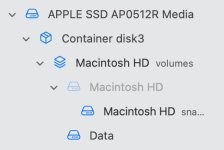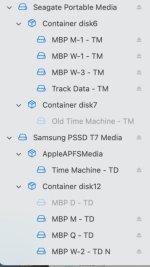Thanks, that image helped a lot. TM has made that change. The operating system allowed TM to make that change as it formatted the area for TM use. But the user doesn't have the same system access to do that.
I did not know that. I've only been able to produce one container per partition. My version of DU only gives me two options when I select Partition, partition or volume. That is why I have thought of partitions as the same as containers. How do you get multiple containers in a partition? That would eliminate the need to do partitions.
Apple has made drive structures very complex with APFS. Let's start with the hardware. At the hardware level, where, for example, we see in your image "Samsung PSSD T7 Media" when you format the hardware as APFS, it creates one Partition with APFS as the structure, and, by default, one Container, with typically one Volume in it. Good so far.
Now, if you want TWO Containers, you use the "Partition" button in DU with either the Container or Volume name highlighted in the left column to create a new partition in which a new Container will be created. Apple uses the term "Partition" here, but it's not like you partitioned at the hardware level because when you go through the process it will not offer a new Partion Map, but only to add a new partition within the GUID Partion Map currently on the hardware. If you choose to create a new partition, it will offer to format it as APFS, but allow changes to make it various kinds of APFS (encrypted, case-sensitive, both) or HFS+ journaled, Case Sensitive or not and the ExFAT or NTFS. You can also set the size. You cannot change the partition map as that was set at the hardware level to be GUID, which makes this "partition" process different from the partition process at the hardware level where you can pick the partition map format between GUID and MBR. You can also name the partition, which will be the name of the Volume in the Container. Once the process is completed to make a new "partition" on the drive, the DU window will now show the hardware drive at the top, then multiple Containers with Volumes in them. At this point the first partition will be renamed to "AppleAPFSMedia" like you show. I don't know why that happens but it's not changeable. What is curious to me is that if the new Container is now deleted by selecting the harware, then Partition and click on the new partition and then the "-" button below the pie chart display, DU will ask if you want to delete the Container and if you say yes to that, the process will proceed very quickly and the progress window will report that the container is being deleted, never using the word "partition" but at the end of the process, the hardware will now show ONE single area, as expected, but the Container name will remain "AppleAPFSMedia" again with no way to change it. Apple has some quirks in APFS and without any user documentation, it's hard to determine exactly what is going on. I think what is happening is that to create a second Container Apple has chosen to use the term "partition" to define the area of the Container within the APFS area of the hardware itself. But Apple has released no technical information on APFS, so all of this is pure speculation based on experiments with the hardware.
In any event, at the end of the day for the "partition" process there are now two Containers on the drive with Volumes in them. Those Volumes can be renamed, but the Containers cannot. However, one of the Containers has been renamed to "AppleAPFSMedia" and the other given a "Container disk ##" name. The Hardware is not really in multiple partitions in a harware sense, as the entire drive is being controlled by APFS as it was set up when the hardware was initialized.
Functionally, yes, there are multiple areas called partitions that each have a Container within. Technically, at the deep drive level, there is still only one true partition, an APFS partition that now has multiple Containers. Each Container has a fixed amount of space in it, which is shared with each volume in it. Deleting a Container restores the "partition" as well, uniting the freed space to the other "partition" on the hardware. At least it appears to do so when the deleted Container is the second container on the drive. It also appears that one cannot delete the first Container on a hardware device if there is a second, but you can delete the second and the space will be merged back to the first in the process. I didn't experiment with three Containers, but suspect that only the "last" Container can be deleted at any given time, and the space will be recovered by the next-to-last. I might do some playing with that when/if I get the time.
By the way, I did some experimentation to get that information, using an HD, not an SSD, for the Container creation and removals, so it's not related to being HD or SSD.
Sorry that was long, and probably confusing. Apple has been very stingy with information about how APFS works and most of this that I have provided comes from guys like Howard Oakley at eclecticlight.co, where he has a lot of articles on APFS that he has extracted from his own research as a macOS SysOp and expert. Start here:
Macs, painting, and more

eclecticlight.co
click the search icon and type in either "APFS" or "Container" and read some of the 83 pages of articles on the subject.
But the bottom line is that I am 99.9% sure Containers cannot be renamed by the user and that other than in Disk Utility, cannot be seen at all in normal use.








